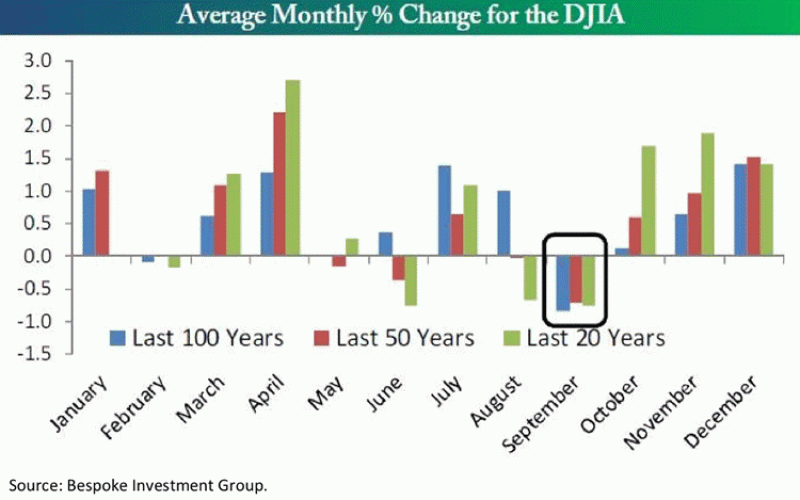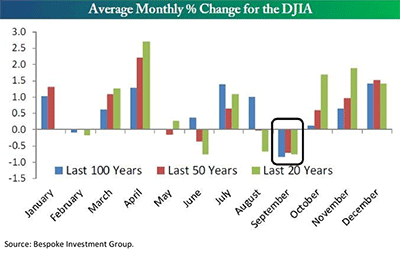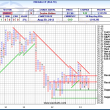“Money and Savings?”
by Jeffrey Saut, Chief Investment Strategist, Raymond James
September 3, 2013
“It so happens that I spend a fair amount of time thinking and reading and teaching and writing about money. I talk about savers getting ripped off, about trustees who can’t be trusted, about accountants from whom you simply cannot ever get a straight count, and about geniuses like Warren Buffett who make their investors rich. Money is a vital life enhancer. If you have it, you can enjoy life incomparably more than if you don’t. The great storehouses of travel, leisure, rest, refinement, appearance, health, above all, peace of mind – all of these are open to you if you have money. It doesn’t have to be millions, or even hundreds of thousands. But it has to be enough so that you can know from one hour to the next that you are not going to be starved, dunned by your creditors, thrown out of your apartment, put on the street, or made to fear becoming homeless. (All this) has made me consider once again my parents and how very different their lives are. My parents, who are not really rich, have never, as adults, as far as I can recall, been seriously worried about money. There is a simple reason for that; they have always lived modestly, even frugally, and have always had wants that are modest compared with their means. They are not geniuses at investing and have never been wildly well paid. They have just been like the ant. Laying aside money year in and year out, and now they have a comfy cushion around them. Their friends and colleagues of their age all seem to be similarly situated. What I keep coming back to is that the real bottom line is a simple idea that the savers know and the terrorized don’t: Money is not for spending. Money is first for saving, and then for spending.
Or, you might put it a different way. Money is for spending on a rainy day. If that rainy day doesn’t come in your life, it might come in your children’s. Money is protection, the shield and the buckler for your family and for you. There is no new suit of clothes, no vacation, and no new car that can offset the pain of being truly worried about running out of money. I have had that fear. It comes at about five in the morning, and it keeps you awake and makes your mouth dry and makes you hate the sound of the birds singing in the morning. It’s probably not realistic in my case, but I don’t want anyone I love to come even close to it.”
... The American Spectator, by Benjamin J. Stein (March 1995)
I spoke to Ben Stein (American actor, writer, lawyer, and commentator on political and economic issues) a few weeks ago, and his parents sound a lot like my grandparents. My grandparents, and their peers, were just starting out in life during the depression. After experiencing those horrible economic times, saving for a rainy day became second nature. Their first worry was their job; then to put money away to buy a home and educate their children. Stocks never even entered their mind after the 1929 “crash” and the 1930 Depression years. Financial survival for them was the order of the day. They did without things to ensure they would never have to suffer economic hardships again. And most of all, they wanted to make certain their children wouldn’t either. There has been nothing like the 1929 crash, and the ensuing Depression years, since then; although for my generation the late-2007 through mid-2009 experience came close when the Dow Dive lopped an eye-popping 54.4% from the D-J Industrial Average (INDU/14810.31).
“Money is not for spending. Money is first for saving and then for spending.” What an interesting and important concept. Regrettably, subsequent generations to my grandparents mostly don’t believe it. Well, that’s not entirely true. The Baby Boomers (1946 – 1964), many of whom watched their stock market net-worth decline by more than 50% in the October 2007 to March 2009 debacle have hence learned the importance of savings. But, few of the Generation X (1965 – 1979), Gen Y’ers (1980 – 2000), or Gen Z’ers (2001 – present) have learned that lesson. To be sure, what determines your stock market performance (aka, savings) is not how you manage your winners, but how you manage your losers; how to avoid the big loss! And, in learning how not to lose money you have to evaluate risk, as well as how to manage that risk.
While I too believe that nobody can consistently “time” the markets, I also think if you listen to the message of the markets you can determine if you should have an aggressive investment strategy, or a not so aggressive strategy. To this risk management point, consider this. If in October 2007 you owned a $100,000 S&P 500 Index Fund, and were “in it for the long term” knowing it was a “plan” and not a short-term scheme, by the ultimate lows of March 2009 you had lost 57.7% of your money. If you continued to stick with that position until last Friday, you have made a grand total capital gain over that nearly six-year holding period of only 0.057% (excluding dividends). However, if you heeded the Dow Theory “sell signal” of November 2007 and decided to hedge your $100,000 “long” S&P 500 Index (SPX/1632.97) position using any number of suitable instruments, the combined portfolio may have posted a much more worthy gain over the October 2007 to March 2009 timeframe. The point is that you don’t have to constantly buy this, or sell that, but rather that the concept of managing risk is the central theme in attaining your long-term saving’s goals.
Over the past few months that is what I have been attempting to do (manage the risk), albeit with limited success, at least so far. I had targeted the mid-July through mid-August timeframe as the first window of the year for a meaningful decline to begin. I also noted that the timing models suggested the stock market’s internal energy would be totally used up on the exact date of July 19th; so that if you wanted a D-day, July 19th was it. And quite frankly, even though we did see a few “print highs” above the July 19th closing price of 1692.09, they were only marginally higher “closes” with most investors not making much money since mid-July. More importantly, the SPX is down about 4.5% from its August 2nd high and many stocks are down more than that. By my work, the SPX remains in a corrective mode, although we should get another rally attempt on the administration’s “no Syria” attack over the weekend. Unfortunately, I don’t think the correction is over. While it is true nobody knows when the ongoing pullback will end, or how deep it will be, my suspicion remains it will be below 1600 and above 1500 before it is over.
The call for this week: Mark Twain once said, “October: this is one of the peculiarly dangerous months to speculate in stocks. The other are July, January, September, April, November, May, March, June, December, August, and February.” And while it’s true, October is viewed by many as the most dangerous month due to the various stock market crashes associated with it, September is truly the worst month historically. Indeed, September has seen the worst average returns for the D-J Industrials over the past 50 and 100 years. The average monthly loss during the last 20 years has been 0.75% (see chart on page 3). That said, the stock market is again short-term oversold and registered a 90% Downside Day last week (8/27) whereby 90% of total trading volume came in on the downside. Such Downside Days tend to be followed by two- to seven-session rally attempts. The no missile strike over the weekend should provide the causa proxima for such a rally, but I doubt it can sustain much above my long standing 1684 “pivot point.”
P.S. – I hosted a conference call last week with my friend, and keen-sighted growth stock portfolio manager of the Lord Abbett Growth Leaders Fund (LGLAX/$19.57), Tom O’Halloran. Tom mentioned a number of stocks during that “call,” some of which are followed by Raymond James’ research department, and some of which are not. I looked at all those companies’ fundamentals and suggest you do the same. The playback number for that conference call number is (855) 859-2056 and the password is 29473014.















